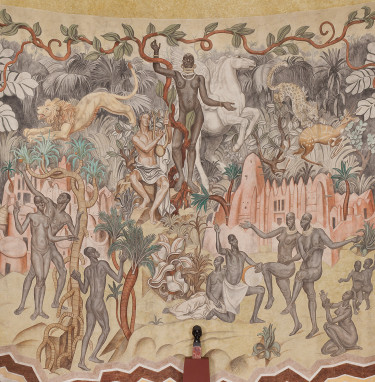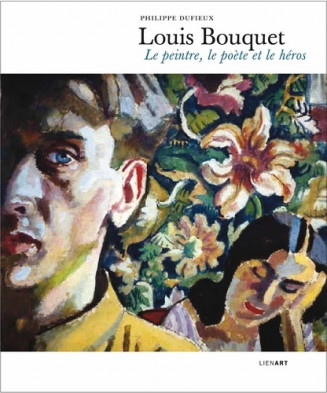Louis Bouquet’s fresco

The fresco that decorates the Africa Salon, situated in the south-west corner of the Hall of Honour, and classified as a historic monument since 1987, was created by the Lyon-based painter Louis Bouquet (1885-1952). Its purpose was to depict the cultural and intellectual contributions made by Africa.
On the right-hand panel, devoted to Black Africa, music and dance are portrayed, with Apollo holding his lyre, inspired by a majestic black muse, the two of them surrounded by dancers. The décor consists in lush vegetation, inhabited by wild beasts (a lion, a leopard hunting an antelope) and architecture representing the Great Mosque of Djenné, the biggest building made from raw earth in the world, located in Mali and dating from 1906. Interesting fact: the Mosque of Djenné was also reproduced in a miniature version to serve as a pavilion representing Mali at the Colonial Exposition.
Opposite the entrance door, three panels illustrate the Arab sciences and arts, with each one represented by an allegorical character: on the right-hand panel, astronomy (man holding a celestial globe, looking to the sky), mathematics (man counting on his fingers), geometry (man with a compass), agronomics (man carrying a hoe), botany (woman picking plants), medicine and pharmacopoeia (man with a mortar and pestle), philosophy (two characters in the midst of a debate), poetry (woman holding a lyre), eloquence (a man proclaiming, his arm extended); the central panel features music and song, while the left-hand panel depicts writing and architecture.
Lastly, to the left of the entrance, religion is embodied by Mohammed, the angel Gabriel (Jibril in Arabic) whispering into his ear the Revelation of the Koran, accompanied by the figure of Saint Michel bringing down the dragon, symbol of Evil. The angel Gabriel and Saint Michel are figures venerated by both Christianity and Islam, and are very much present in their respective iconographies: the painter thus wished to highlight the points of convergence between eastern and western cultures through music, the sciences and religion.
Above the panels are a large number of architectural models (mosques, cities, palaces…) illustrating the wealth of urban cultures in Arab-Muslim civilisations.
As concerns the treatment of the characters, dignified and impressive, their fixed, frontal and aloof positions are the most striking aspect. Their sobriety echoes a certain neutrality in their expressions and in the sculptural appearance of the bodies.
The painter’s touch is defined and linear, with the paint applied in low-key flat tints (with no trace of brush strokes), and cross-hatched lines placed vertically, accentuating the impression of verticality of the walls of the large oval cylinder of this salon.
Likewise, cross-hatching reinforces the geometrization of the objects and bodies depicted. The forms are elongated and the figures elegant and slender, which also accentuates the verticality of the architecture. The entire fresco is approached through a geometric framework in which the stylised arabesque is very much present.
The colour range is limited to the colours of the earth, presented tone-on-tone, creating a general palette that is muted, accentuating the sculptural appearance of the silhouettes. A few touches of bright colour highlight materials or objects.
Also to be read

Louis Bouquet, le peintre, le poète et le héros, Philippe Dufieux, Lienart éditeur, 2010
Author of the fresco that decorates the Africa Salon of the Palais de la Porte Dorée, this painter from Lyon, a pupil of Maurice Denis, established himself as one of the brilliant decorators of the inter-war period and took part in the prestigious building sites of his time. This book sheds light on the work of this artist, who should be rediscovered.



